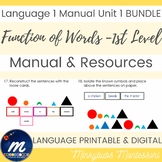Montessori Detective Adjective Game Printable Triangles, Command Cards, & Labels
- PDF
Also included in
- Montessori command cards are for practicing independent work in language and grammar.Many other command card sets do not include the answer on the back, which makes the child reliant on the teacher for the control of error.Thank you for taking the time to look at this product!***********************Price $20.00Original Price $34.25Save $14.25
- Montessori command cards are for practicing independent work in math.Many other command card sets do not include the answer on the back, which makes the child reliant on the teacher for the control of error.Thank you for taking the time to look at this product!***************************************Price $27.00Original Price $53.25Save $26.25
- Determining the Function of Words: 1st LevelIn this grammar unit we will learn the 9 basic parts of speech:NounArticleAdjectiveVerbPronounAdverbPrepositionConjunctionInterjectionSave yourself HOURS of work.This is Unit 1: The Function of Words: 1st LevelThis resource is relevant to ANY child, regardPrice $80.00Original Price $125.55Save $45.55
Description
The purpose of the detective adjective game is to show the child the detective power of the adjective - with the help of the adjective it is possible to single out one from a large group.
This is a GREAT game to play for one child or a group of children. It is also perfect for homeschoolers and Montessori-inspired teachers!
While it does reinforce the geometry concept and nomenclature of the 7 triangles of reality, it is an excellent language game. The Detective Adjective Game is a unique and fun exercise which combines language skills with geometric recognition. The set consists of sixty-three triangles (twenty-one each in yellow, blue and red) of different sizes and types. It can be used with children as soon as they can discriminate the different types of triangles and some angles (right, acute, obtuse).
The triangles are:
- 3 sizes: small, medium, large
- 3 colours: red, yellow, blue
- 3 kinds of isosceles triangles: acute, right angle, obtuse angle
- 3 kinds of scalene triangles: acute, right angle, obtuse angle
- equilateral triangles
This is the only detective adjective resource that includes all of the following:
- Material Analysis
- Presentation instructions
- 63 triangles to be sorted - black outline to print on coloured card (save printer ink and print these triangle outlines on coloured paper. You will need 7 sheets each of red, yellow, and light blue)
- 63 triangles to be sorted - in colour to print on white card (You will need 21 pages of white card stock)
- 63 Command Cards to help identify the different triangles using adjectives (you will need 11 pages on white card stock)
- 63 Labels to place under the corresponding triangles (you will need 6 pages on white card stock)
- Description of the type of triangle on the printable
- Photograph of the material








